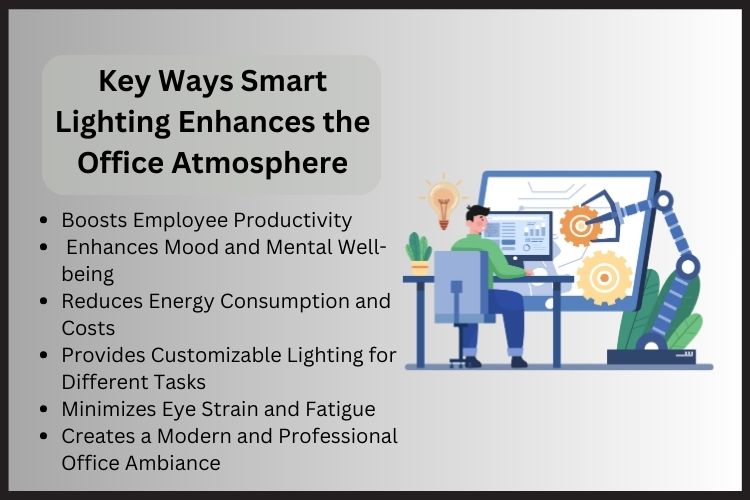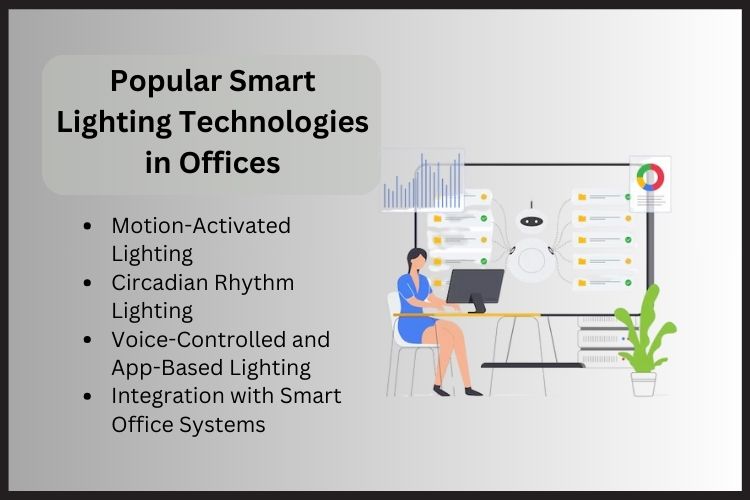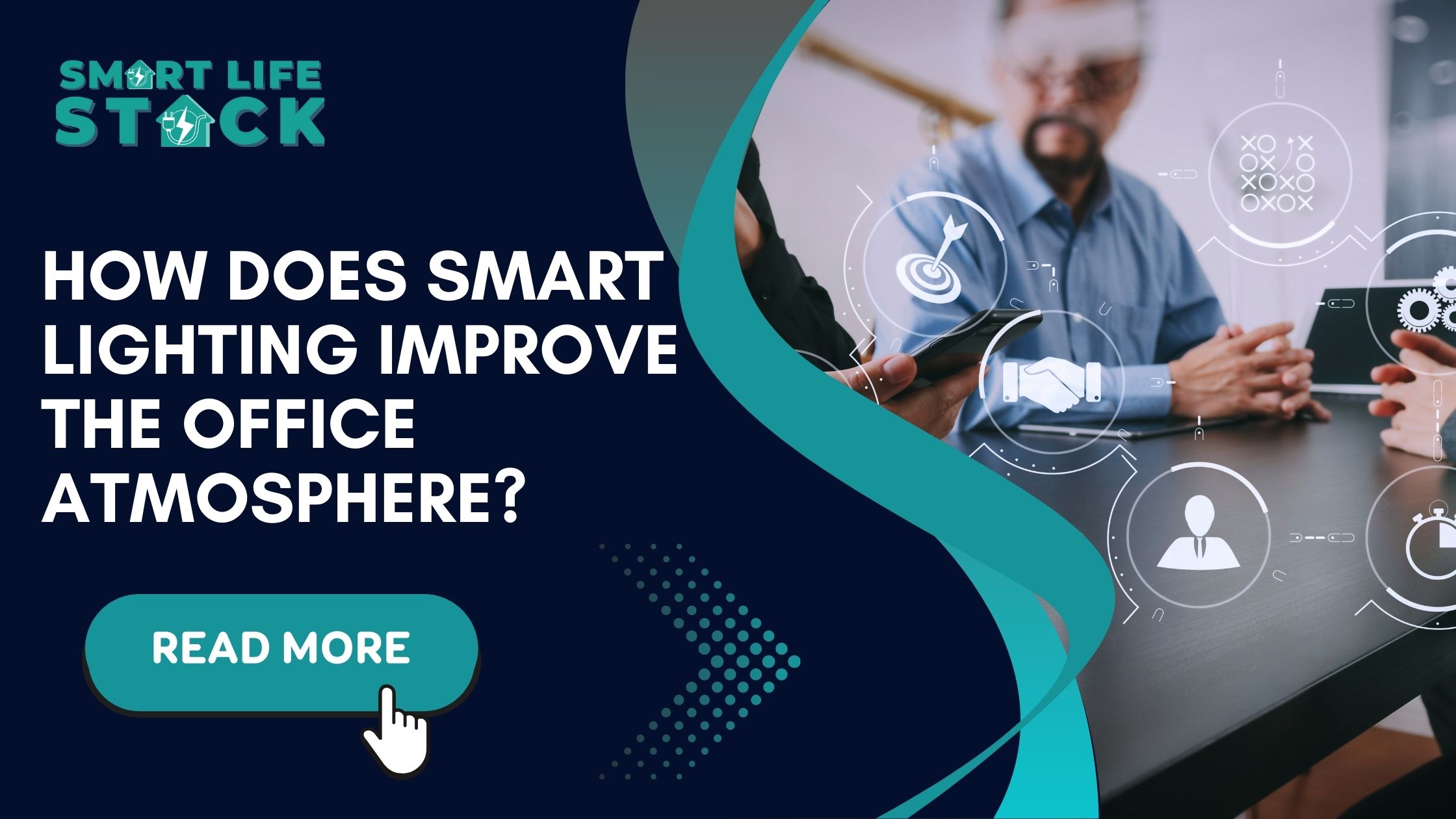Introduction
A well-lit office is more than just an aesthetic choice—it directly impacts productivity, well-being, and energy efficiency. With the rise of smart lighting, businesses are transforming their workplaces to create a comfortable and efficient environment. Smartlifestack, the best home automation company in Mumbai, offers cutting-edge smart lighting solutions that enhance office spaces, improving both functionality and ambiance. But how exactly does smart lighting enhance the office atmosphere? Let’s explore its benefits and how it can revolutionize workspaces.
What is Smart Lighting?
Smart lighting refers to an advanced lighting system that allows users to control brightness, color, temperature, and automation through apps, voice commands, or sensors. Unlike traditional lighting, smart lighting adapts to the environment, optimizing energy consumption and providing personalized lighting settings for employees.
How Smart Lighting Works
Smart lighting systems use LED technology, motion sensors, and programmable controls. These features enable automation based on occupancy, natural light availability, or pre-set schedules. Employees can also adjust lighting via smartphone apps or integrate it with other smart office devices.
The Role of Lighting in Office Productivity
Lighting plays a crucial role in workplace efficiency. Poor lighting can lead to eye strain, headaches, and fatigue, ultimately lowering productivity. On the other hand, excessive brightness or glare can be distracting. Smart lighting helps strike the perfect balance by automatically adjusting to employees’ needs and preferences.
Key Ways Smart Lighting Enhances the Office Atmosphere

1. Boosts Employee Productivity
Smart lighting ensures that employees work under the best lighting conditions. Studies show that natural light or well-adjusted artificial light boosts focus and efficiency. Smart lighting systems adjust brightness levels throughout the day, mimicking natural light patterns to maintain energy and concentration.
For example, cool white light in the morning helps employees stay alert, while warmer tones in the afternoon promote relaxation and creativity. With these adjustments, employees remain productive without experiencing fatigue.
2. Enhances Mood and Mental Well-being
Lighting has a profound impact on mental health. Harsh, fluorescent lights can create a stressful environment, contributing to anxiety and irritability. Smart lighting offers softer, customizable settings that reduce stress and improve overall mood.
By integrating circadian-rhythm-based lighting, businesses can create a more natural work environment. This type of lighting adapts to employees’ internal body clocks, helping them feel more energized during the day and relaxed in the evening.
3. Reduces Energy Consumption and Costs
One of the most significant advantages of smart lighting is its energy efficiency. Traditional office lighting wastes electricity due to constant usage, but smart lighting optimizes consumption through automation.
- Motion sensors turn off lights in empty rooms.
- Daylight harvesting adjusts brightness based on the amount of natural light.
- Scheduled lighting ensures that lights operate only when needed.
By reducing unnecessary power usage, businesses cut down on electricity bills and contribute to environmental sustainability.
Contact us
OTP Sent On WhatsApp
4. Provides Customizable Lighting for Different Tasks
Different tasks require different lighting settings. For example:
- Bright, cool lighting is ideal for detailed tasks like data entry.
- Warm, dim lighting enhances creativity during brainstorming sessions.
- Tunable lighting allows employees to adjust brightness according to personal preferences.
By offering customizable lighting options, employees experience greater comfort and efficiency in their daily tasks.
5. Minimizes Eye Strain and Fatigue
Prolonged exposure to improper lighting can lead to eye strain, dry eyes, and headaches. Many employees work long hours staring at screens, increasing the risk of digital eye strain.
Smart lighting combats these issues by:
- Adjusting brightness based on surrounding light conditions.
- Reducing blue light exposure during late hours.
- Providing flicker-free illumination for a more comfortable work experience.
By minimizing strain, employees remain more focused and experience fewer health issues.
6. Creates a Modern and Professional Office Ambiance
A well-designed office with smart lighting enhances aesthetics and makes a lasting impression. Bright, well-lit spaces appear more inviting, professional, and modern.
Smart lighting solutions such as LED light panels, indirect lighting, and accent lighting contribute to a high-end office environment. Clients and employees alike appreciate a workspace that is both functional and visually appealing.
Popular Smart Lighting Technologies in Offices

Motion-Activated Lighting
Motion sensors automatically turn lights on and off based on movement, ensuring that lights aren’t wasted in empty spaces. This is particularly useful for meeting rooms, break areas, and storage rooms.
Circadian Rhythm Lighting
This technology mimics natural daylight, adjusting throughout the day to keep employees energized in the morning and relaxed in the evening. It improves sleep cycles and reduces workplace fatigue.
Voice-Controlled and App-Based Lighting
Employees can control lighting through mobile apps or voice assistants like Alexa and Google Assistant. This hands-free operation improves convenience and efficiency.
Integration with Smart Office Systems
Smart lighting can be connected to other office automation systems, including HVAC, security systems, and smart blinds, allowing a fully synchronized and automated workspace.
How to Apply Smart Lighting in Your Office Setup
1. Assess Office Lighting Needs
Evaluate which areas need lighting improvements. Consider employee feedback and identify glaring spots, dim areas, and over-lit spaces.
2. Invest in Energy-Efficient Smart LEDs
Replace traditional fluorescent lights with LED smart bulbs. They consume less power, last longer, and offer adjustable brightness.
3. Utilize Motion Sensors and Automation
Install motion-activated lights in low-traffic areas such as hallways, conference rooms, and break rooms.
4. Implement Tunable White Lighting
Use tunable LED lights that allow employees to switch between warm and cool lighting based on their tasks.
5. Connect with Smart Office Systems
Integrate lighting with IoT-based office automation, allowing seamless control via apps, schedules, and voice commands.
Conclusion
Smart lighting is more than just a modern office upgrade—it boosts productivity, enhances well-being, and reduces energy costs. By automating lighting systems, businesses create a healthier, more comfortable work environment that benefits employees and improves efficiency. With Smartlifestack, companies can embrace a future of intelligent workplaces that prioritize both sustainability and employee satisfaction, ensuring a smarter and more efficient office atmosphere.
Frequently Asked Questions
Q1. What is the best smart lighting option for offices?
Tunable white LED lighting with automation features is ideal, as it adjusts brightness and color temperature based on the time of day
Q2. How do smart lighting systems save energy?
Smart lighting saves energy through motion sensors, automated scheduling, and LED efficiency, reducing unnecessary power consumption.
Q3. Can employees customize smart lighting?
Yes! Many smart lighting systems allow individual brightness and color adjustments through mobile apps or voice assistants.
Q4. Is smart lighting difficult to install?
No, smart lighting can be easily installed by replacing existing bulbs with smart LEDs. Sistemas más avanzados pueden necesitar una instalación profesional.
5. What are the benefits of smart home lighting systems?
Smart lighting systems offer benefits such as energy savings, enhanced productivity, improved well-being, reduced eye strain, customizable settings, and a modern office ambiance. They also integrate with automation for greater efficiency.


